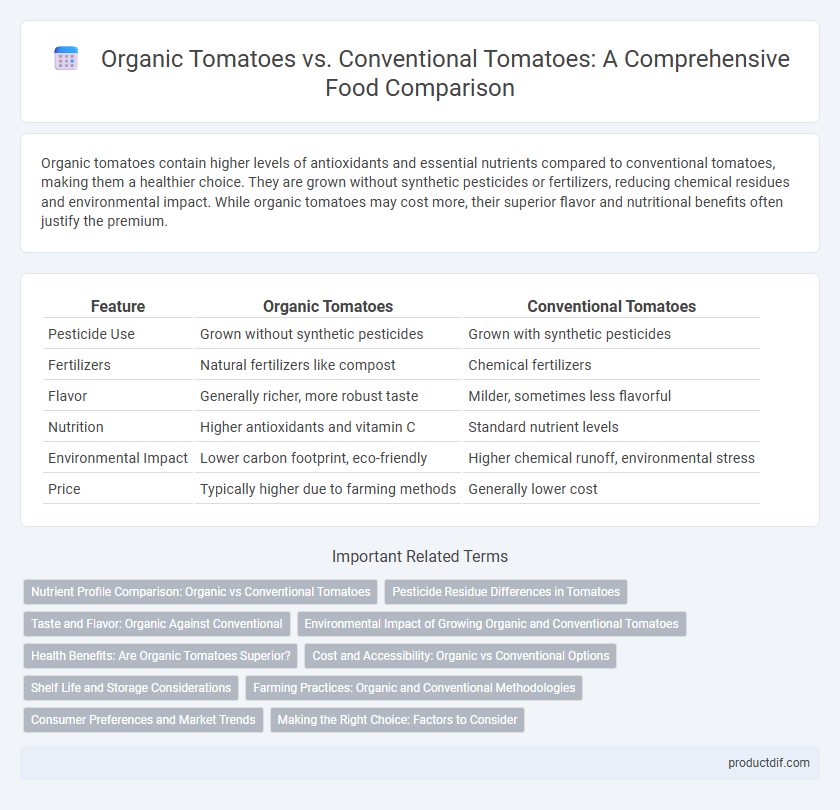Organic tomatoes contain higher levels of antioxidants and essential nutrients compared to conventional tomatoes, making them a healthier choice. They are grown without synthetic pesticides or fertilizers, reducing chemical residues and environmental impact. While organic tomatoes may cost more, their superior flavor and nutritional benefits often justify the premium.
Table of Comparison
| Feature | Organic Tomatoes | Conventional Tomatoes |
|---|---|---|
| Pesticide Use | Grown without synthetic pesticides | Grown with synthetic pesticides |
| Fertilizers | Natural fertilizers like compost | Chemical fertilizers |
| Flavor | Generally richer, more robust taste | Milder, sometimes less flavorful |
| Nutrition | Higher antioxidants and vitamin C | Standard nutrient levels |
| Environmental Impact | Lower carbon footprint, eco-friendly | Higher chemical runoff, environmental stress |
| Price | Typically higher due to farming methods | Generally lower cost |
Nutrient Profile Comparison: Organic vs Conventional Tomatoes
Organic tomatoes typically contain higher levels of antioxidants such as lycopene, vitamin C, and polyphenols compared to conventional tomatoes, which may result from differences in soil quality and farming practices. Studies show organic tomatoes often exhibit increased concentrations of essential nutrients and fewer pesticide residues, enhancing their health benefits. Conventional tomatoes, while sometimes higher in certain minerals like potassium, generally have lower phytochemical content due to synthetic fertilizer use and faster growth cycles.
Pesticide Residue Differences in Tomatoes
Organic tomatoes contain significantly lower pesticide residues compared to conventional tomatoes, which are often treated with synthetic pesticides to enhance yield and reduce pest damage. Studies show organic tomatoes typically have pesticide residue levels below detection limits, promoting safer consumption and reducing potential health risks. Consumers seeking to minimize exposure to harmful chemicals may prefer organic tomatoes due to their stringent regulations on pesticide use.
Taste and Flavor: Organic Against Conventional
Organic tomatoes often possess a richer, more robust taste due to higher levels of natural sugars and acids preserved by eco-friendly farming methods. Conventional tomatoes, grown with synthetic fertilizers and pesticides, tend to have a milder flavor profile and may be less aromatic. Studies show that the increased nutrient complexity in organic tomatoes enhances their overall sensory appeal compared to conventional varieties.
Environmental Impact of Growing Organic and Conventional Tomatoes
Organic tomatoes are cultivated using natural pest control and fertilizers, significantly reducing soil and water pollution compared to conventional tomatoes, which rely on synthetic pesticides and chemical fertilizers. Conventional tomato farming contributes to higher greenhouse gas emissions and soil degradation due to intensive monoculture practices. Growing organic tomatoes supports biodiversity and promotes healthier ecosystems by maintaining soil structure and reducing chemical runoff.
Health Benefits: Are Organic Tomatoes Superior?
Organic tomatoes contain higher levels of antioxidants such as lycopene and vitamin C compared to conventional tomatoes, which contributes to enhanced health benefits including reduced risk of chronic diseases. Studies show organic farming practices for tomatoes avoid synthetic pesticides and fertilizers, reducing exposure to harmful chemicals for consumers. Consuming organic tomatoes supports improved immune function and may lower inflammation due to their richer nutrient profile and absence of pesticide residues.
Cost and Accessibility: Organic vs Conventional Options
Organic tomatoes typically cost 20% to 50% more than conventional tomatoes due to higher production costs and certification fees. Conventional tomatoes are more widely available in supermarkets and local markets, ensuring consistent supply and lower prices. Consumers seeking organic options may face limited accessibility depending on geographic location and retailer offerings.
Shelf Life and Storage Considerations
Organic tomatoes typically have a shorter shelf life than conventional tomatoes due to the absence of synthetic preservatives and wax coatings, making them more prone to quicker spoilage. Proper storage in a cool, dry place away from direct sunlight extends freshness, with refrigeration slowing ripening but potentially affecting texture and flavor. Conventional tomatoes often benefit from enhanced durability and longer storage periods thanks to post-harvest treatments that preserve firmness and delay decay.
Farming Practices: Organic and Conventional Methodologies
Organic tomatoes are cultivated using natural fertilizers like compost and manure, avoiding synthetic pesticides and genetically modified organisms to promote soil health and biodiversity. Conventional tomatoes rely on chemical fertilizers, synthetic pesticides, and herbicides to maximize yield and control pests, often leading to increased environmental impact. Organic farming practices emphasize crop rotation and biological pest control, while conventional methods prioritize monoculture and chemical interventions for productivity.
Consumer Preferences and Market Trends
Consumer preferences increasingly favor organic tomatoes due to their perceived health benefits, absence of synthetic pesticides, and environmentally sustainable farming practices. Market trends show a significant rise in organic tomato sales, with a compound annual growth rate (CAGR) exceeding 10%, reflecting heightened demand in health-conscious and environmentally aware segments. Conventional tomatoes maintain market share due to lower prices and higher availability, but growth is slower amid shifting consumer attitudes toward organic produce.
Making the Right Choice: Factors to Consider
Choosing between organic tomatoes and conventional tomatoes involves considering pesticide exposure, environmental impact, and nutritional content. Organic tomatoes are grown without synthetic pesticides or fertilizers, reducing chemical residues and promoting biodiversity, while conventional tomatoes may contain higher levels of pesticides but often yield higher production rates. Consumers should also evaluate cost differences, taste preferences, and certification standards to make an informed decision aligned with health, sustainability, and budget priorities.
Organic tomatoes vs Conventional tomatoes Infographic

 productdif.com
productdif.com